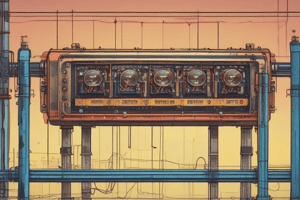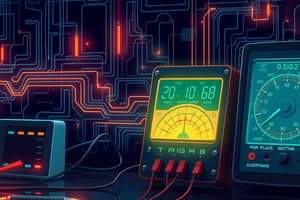Podcast
Questions and Answers
What primary distinction exists between a parallel circuit and a series circuit?
What primary distinction exists between a parallel circuit and a series circuit?
- In a series circuit, the total voltage is divided among components. (correct)
- In a parallel circuit, components share the same current.
- In a parallel circuit, components are connected end-to-end.
- In a series circuit, components can operate independently.
Which component is primarily responsible for providing power in the circuit configurations discussed?
Which component is primarily responsible for providing power in the circuit configurations discussed?
- Spannungsquelle (correct)
- Funkstrahlung
- Lampe
- E-Auto
What is the effect of connecting components in a parallel configuration compared to a series configuration?
What is the effect of connecting components in a parallel configuration compared to a series configuration?
- Parallel connection increases total resistance.
- Parallel circuits require a single path for current.
- In parallel, the current is shared among components. (correct)
- In series, voltage remains constant across all components.
What does the term 'Stromkreis' refer to in the context of electrical circuits?
What does the term 'Stromkreis' refer to in the context of electrical circuits?
In discussing voltage sources, what is meant by 'plus und minus' poles?
In discussing voltage sources, what is meant by 'plus und minus' poles?
Flashcards
Parallel Circuit
Parallel Circuit
A circuit with multiple branches, where current can flow through different paths.
Series Circuit
Series Circuit
A circuit with components connected in a single path, current flows through all components sequentially.
Voltage Source
Voltage Source
A device that provides electrical potential difference (voltage) to drive current flow.
Current Flow
Current Flow
Signup and view all the flashcards
Circuit
Circuit
Signup and view all the flashcards
Study Notes
Physics Notes
- Electricity: Deals with the flow of electric charge
- Voltage Sources: Called voltage sources, these are like batteries or power supplies
- Circuits: Circuits show how electrical components are connected
- Parallel Circuits: Components are connected side-by-side. Voltage across each component is the same.
- Series Circuits: Components are connected end-to-end. Current through each component is the same.
- Components: Devices that use or create electricity (e.g., lamps, heating elements).
- Heat devices: Devices that create heat (e.g., hair dryers, refrigerators).
- Voltage: Pushing force that moves electrons through a circuit.
- Current: Flow of electrons through a circuit.
- Resistance: Opposition to the flow of electric current.
- Household Appliances: Examples: heaters, refrigerators, lamps.
- Electrical Diagrams: Visual representations of electric circuits.
Studying That Suits You
Use AI to generate personalized quizzes and flashcards to suit your learning preferences.
Description
This quiz covers key concepts in electricity and circuits, including voltage sources, current flow, and resistance. Explore both parallel and series circuits along with common household appliances that use electricity. Test your understanding of electrical diagrams and components.





